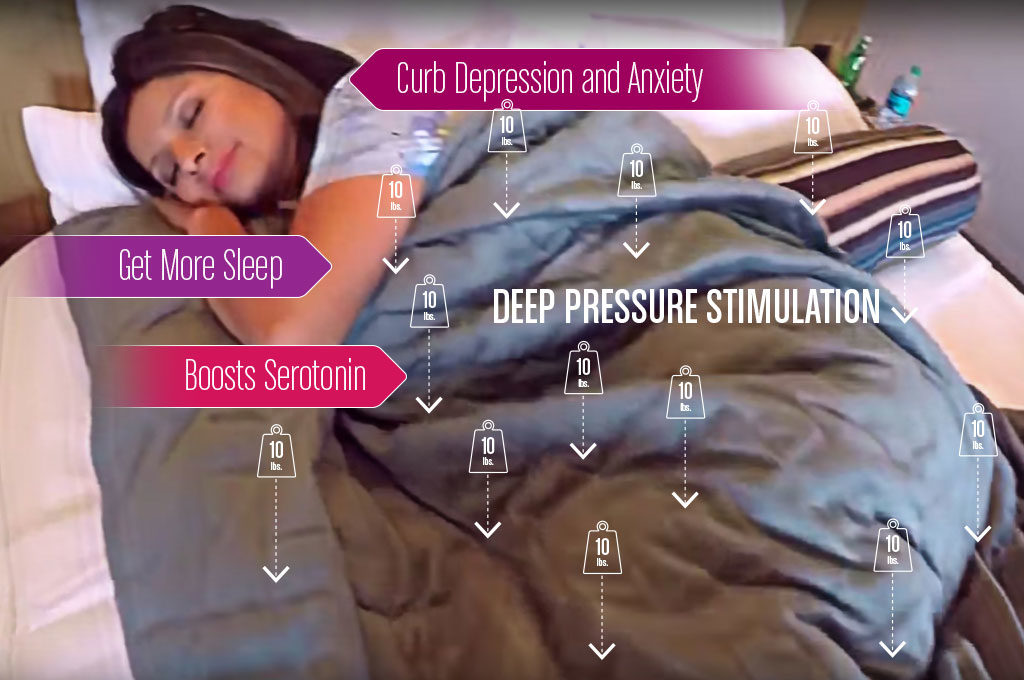Chronic pain is often an unseen condition, and all to often those who suffer from it choose to remain silent. Some may not realize what they are experiencing is even chronic pain and will instead ignore it in the hopes that it will go away. Those who are fortunate enough to get their problem diagnosed face a new problem in choosing how they wish to treat their pain. Many of the most commonly prescribed pain killers are potentially addictive, while more holistic approaches may be hampered by the pain itself.
But can something as simple as a weighted blanket help to treat chronic pain? You may be surprised to learn that weighted blankets can be a powerful tool as part of ongoing treatment. By utilizing deep pressure stimulation, weighted blankets help promote pain relief and deeper, more restful sleep. Though weighted blankets are by no means a cure for chronic pain and related issues, using one as part of an ongoing treatment plan can get you better results.
What Is Chronic Pain?
The medical community defines chronic pain as any pain that lasts twelve weeks or longer. Such a long window of time should be a clear indicator that something is amiss; most injuries would have healed before then. A staggering twelve percent of Americans report suffering from chronic pain. But with many people choosing not to report their symptoms or believing that they are normal; some argue that the number is actually higher. Chronic pain can affect any part of the body.
Causes
There are a wide variety of potential causes of chronic pain. The simple explanation is that the affected nerves continue to send signals to the brain identifying an injury despite the healing process already having taken place. Such misfires can result from simple injury, neurological distress (such as headaches and migraines), infections, and surgery, as well as conditions like fibromyalgia and arthritis. The pain itself need not be severe to be considered chronic, and in some cases, patients report it as a mild, dull ache.
The dangers of living with chronic pain reach far beyond the continuing discomfort it brings. It’s been noted that those living with chronic pain suffer higher rates of depression and anxiety. It also becomes difficult to sleep, which may lead to insomnia or other sleep disorders and generally affects one’s mood and energy levels. But perhaps the biggest threat posed by chronic pain is how those who suffer from it grow to avoid physical activity, thinking it will only increase their pain. Such avoidance can lead to weight gain, obesity, and related physical health issues that can lead to an early death.
When you take all of these things into consideration at once, it becomes obvious that chronic pain isn’t a singular condition but rather a multitude of difficulties that can greatly impact one’s quality of life. The public’s general understanding of it—that it’s wholly related to physical pain—may very well be why it overwhelms so many. The diagnostic time frame of twelve weeks is also an issue when dealing with chronic pain: because other problems develop over time, they may actually set in before twelve weeks have passed, going unnoticed for some time.
How Is Chronic Pain Treated?
Currently, no actual cure for chronic pain is recognized or known to exist. Instead, medical practitioners turn to multiple forms of treatment as part of a pain management program. As the name suggests, pain management is about giving patients tools they need to continue living the life they want while managing their symptoms. Pain management is a life-long practice and will combine the medicines and techniques from different areas of health care.
The first step is usually a course of non-opioid medicines. This can include injections, pills, and radiotherapy. This is the preferred first step because non-opioid medications are not addictive, but because much of what causes chronic pain is still being studied, there’s no way for a doctor to know which medicines will be the most effective. The resulting process of trial and error can become frustrating for patients, who may become disheartened and push to move straight to more heavy-duty paths of treatment.
Cognitive Behavioral Therapy

Another approach used early on is purely psychological. Cognitive behavioral therapy, or CBT, is more commonly used in those with mental illness to help them recognize and cope with their symptoms but can play a role in physical pain management as well. CBT does not involve the use of drugs itself (though it may be used with any ongoing prescriptions). Instead, CBT takes a “mind over matter” approach to recognizing pain: CBT proposes that everything we feel is the result of how we think, including pain. Though it doesn’t reduce the levels of pain one feels, CBT can trigger the body’s natural pain relief systems and make it more bearable.
It’s only after these early treatments have failed to deliver demonstrable results that opioids are considered. These powerful drugs have been used for pain relief for decades but can pose serious risks to patients. Over time their effectiveness can weaken, leading to higher doses. However, opioids are also highly addictive in individuals with histories of mental illness and substance abuse, creating a dependency. Combine these factors with the wide range of side-effects opioids can create and it becomes more clear why some don’t seek treatment for their chronic pain.
Beyond this, a spectrum of alternative and naturalistic treatments have been proposed, and some even swear by them, but the evidence supporting most is sadly lacking and are rarely recommended by medical professionals. While many of these treatments help as a form of physical therapy for acute pain and short-term injuries. Their effectiveness in curbing chronic pain hasn’t been proven. Things like medical marijuana or acupuncture have yet to get an endorsement from the medical community as treatments for chronic pain and are still being studied.
How Do Weighted Blankets Help With Chronic Pain?

If you’re already familiar with weighted blankets; then you’ve likely heard claims that they can help ease symptoms relating to depression and anxiety. They’re commonly used by those seeking who have difficulty sleeping as well. It’s not surprising, then, that weighted blankets have a long history as therapy tools. But you may be shocked to learn they’re an effective way to treat and manage chronic pain and many of its symptoms.
The core concept behind weighted blankets is deep pressure stimulation. In layman’s terms, DPS is the application of firm-yet-gentle pressure that relaxes the nervous system. DPS prompts a series of changes in your body, including muscle relaxation, a lowering of your heart rate, better circulation, and the release of endorphins, serotonin, and dopamine. All of these changes together have a compounding effect that helps you feel more at ease in a multitude of ways:
Boosts Serotonin
On the surface serotonin is a mood stabilizing hormone. But in doing this it aids in sleeping, digestion, mobility, and other bodily functions. Having the right levels of serotonin helps maintain a feeling of mental balance. Not surprisingly, those with chronic physical or mental conditions produce less serotonin than those without; often leading to a worsening of their existing symptoms as well as the development of new ones.
The stress caused by chronic pain greatly reduces the body’s level of serotonin production. It can amplify their physical and mental anguish. But the additional heft of a weighted blanket and its equal distribution across the blanket is a simple form of DPS. They relax the central nervous system and promotes the release of serotonin. Getting serotonin levels normal is a common element among pain management therapy. And DPS is the most simple way to achieve that.
Traditionally people have turned to massage therapy as a form of pain management. While this is also an effective means of DPS; it can become costly with repeated sessions and become affordable very quickly. Weighted blankets allow for the same therapy at a one time cost. With a weighted blanket on hand, you can also alleviate symptoms whenever you want; not just during scheduled appointments.
Curb Depression and Anxiety
By its very nature, chronic pain creates a vicious cycle: the ongoing pain can cause heightened feelings of anxiety and depression, and in time those develop into long-term mental illness. Anxiety and depression create a sort of tunnel vision where you can’t see beyond your pain, making your suffering worse. Common medications and therapies that treat anxiety and depression generally address chemical imbalances that cause those conditions, but because they don’t treat chronic pain the underlying cause will still exist and perpetuate those symptoms.
Increase serotonin helps curb the impact that depression and anxiety can have, but another benefit of DPS is an increased feeling of security. Weighted blankets apply their weight in such a way that simulates a hug or feelings of being held. The calming effect this has can greatly lower anxious feelings and looming depression, leaving you in higher spirits when you wake up. A better mood naturally lends itself to handling pain better and improving your outlook in general.
The importance of addressing anxiety and depression when treating chronic pain can’t be overstated. When depression and anxiety become severe, people are at a higher risk of self-medicating their pain through alcohol consumption. Not only does this make their mental illness symptoms worse. But it can also interfere with any medications being used as well as becoming addictive.
Get More Sleep
Chronic pain conditions come with great irony. Studies have shown that an effective way to manage the associated pain is through regular exercise. But the chronic pain itself causes fatigue. It’s also understandable that someone living with chronic pain would be hesitant to take on physical activity, to begin with. How does one begin doing exercise when they experience pain every day? And how could physical activity possibly curb physical pain?
For starters, physical activity releases powerful hormones that can increase relaxation, promote better sleep, and create a high sensation that dulls feelings of pain for a while. It need not be a vigorous workout or be a strenuous experience to experience these benefits.
Where does a weighted blanket fit into physical activity? Using a weighted blanket when you sleep promotes easier, deeper rest through the gentle pressure of DPS. When you’re able to get a deeper sleep, you’ll have both an improved mood and higher energy levels. Both of these can make the idea of physical exercise less daunting. Regular healthy sleep is also a great tool in fighting depression and anxiety.
Even if you don’t decide to use exercise as part of your pain management plan; good sleep goes a long way towards regulating your mental and emotional well-being, which can influence how you respond to pain. Being better rested can make you feel more prepared for anything you might face during the day.
But Isn’t the Weight Uncomfortable?
How heavy a weighted blanket depends on the manufacturer. So ultimately it’s up to you to find one you’re comfortable with. That being said, by design a weighted blanket should only be about ten to fifteen percent of your own body weight to achieve DPS. Because of this, it’s rare to find a blanket that’s heavy to the point of causing pain. It’s akin to using a stack of winter blankets: snug but not painful.
That said, manufacturers use different fillers for their added weight, and you may find certain materials less comfortable than others. The most commonly reported problem is becoming too hot during warmer months. However, when using an appropriately heavy blanket the additional weight is not a source of discomfort.
 The Healing Power Of Comfort
The Healing Power Of Comfort
In all the ways outlined above that weighted blankets can help treat chronic pain. There’s a common thread of increased comfort. As simple as it sounds, increased comfort plays a huge part in long-term pain management. If you’re looking for a natural, low-cost way to treat your chronic pain and its related symptoms; a weighted blanket could be an invaluable tool to add to your plan.







